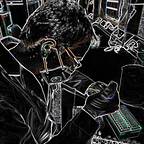Where have Indian Rāgas gone?
At the very outset, let me clarify that I am only quasi-qualified in Indian classical music, but I trained from the very best — which has left me with not much more than a keen ear. I have been wandering across my country for more than a decade now, picking up morsels of what is called ‘folk’ music — and guess it is now time to dispel the myth that Indian classical music is ‘dying’. It is very much alive, with millions of devoted listeners, spread across the breadth and depth of this large country (and maybe abroad). It is played in marriages, pujas (worship), temples, clubs, processions, jagratas (musical all-nighters), sports events — in every smartphone, every bluetooth headset, and every boom box at every rally. Get into an auto-rickshaw for a change, and you will be probably be subjected to a Rāga for sure — there’s no form of public transport in Indian where classical music is not playing.
Let me elaborate. I heard this Punjabi song while in a bus, plying through a country road. It was an eye-opener, an epiphany — that Punjabi songs are much more than the stylized Bhangra avatar which bollywood presents. Punjabis will recognise the song immediately, because it was one of the biggest hits of 2013. It is about the story of a man who gets employed as a cook — not in a five star but a run-of-the-mill plebian restaurant — where he has to make hundreds of chapātis (flatbread) everyday. Everytime he rolls the āttā (dough), he is reminded of his childhood, when his mother used to make little birds out of dough — ‘aatte di chiri’ — for him.
The musical traditions of North India are by and large, intact; a large number of people from Haryana live in Delhi for a living, and bring their music with them in their phones. I picked up this song from one of them, which I immediately recognised to have had heard before — 14 years ago, to be exact, as a remixed bollywood version. Here is the original ‘Hat ja tau’ (‘Move aside and let me dance’) — a staple of Haryanvi marriages, of Khamāj ang.
Move to 2017; the newest Haryanvi sensation is another dance-floor scorcher with 7 million views (‘tere akkha da yo kaajal’), not too far from Raga Bhairavi (never mind the poorly made video, close your eyes and listen).
The official radio station of India, Vividh Bharati, airs folk music from all corners of the country. I heard this one in my car radio, and then traced its origin to Bundelkhand. A newlywed girl moves to her in-laws’ place, and voices her concerns — in Pilu Rāga (‘angna me kuiyan raja’). If you need any further justification on the viability of Pilu — the 18 million views on this song should suffice as ample evidence.
In fact, knowingly or through instinct, composers reproduce the motifs of classical music. This composition (‘matlab ka yaar’, “friends with an agenda”) by Dr Sagar and Rohit Sharma in Rāga Māj-Khamāj, from a mainstream bollywood film, has more than a million views. Add to that the distinctive vocal texture of Swati Sharma.
Coming back to Punjab, the smash hit of 2020 was a refreshingly suave song, Lehnga, by Jass Manak. You cannot stay in Punjab and not hear this song. Thaat Khamāj is written all over it. And it has 1.6 billion views.
I think I have made my point. Indian classical music does not need to be ‘rescused’ by self-professed new age ‘exponents’; nor does it need ‘fusion’ with guitar, saxophone & drums to find acceptance. It has a young and growing audience, and has seeped into the very psyche of Indians. Year after year goes by, yet another ancient Rāga appears in its newest avatar, and sweeps through the heartland of India. Nothing has changed in thousands of years.
Epilogue: Here’s the IPL tune for you; the IPL is the Indian Premier League, the biggest sporting event in the country. The tune seems to be an spruced-up version of the ālāp of Todi Rāga.
